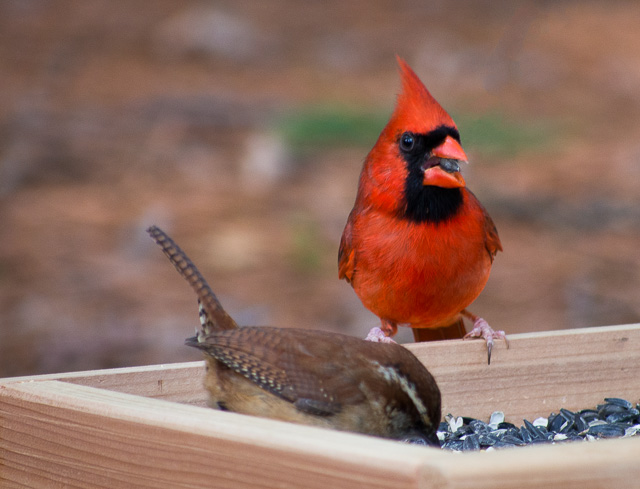
I need a break from hiking through marshes in the winter to photograph birds. For now, I’m trying to make the birds come to my house.
Location
You can try sneaking up on birds in your yard, but you’ll have a tough time getting close. Even if you do, the bird is likely to have branches in the way or have a distracting background. I chose to get a feeder and a blind to control the shot.
I’m using a portable hunter’s blind. It’s essentially a small tent with enough space for a chair and a tripod. I add birdseed to the feeder and then hang out in the blind. Right now I have to wait a few hours for a shot, but that should improve as more birds discover this source of food. Luckily I’m within range of my home’s wifi. At least I can get some work down while I’m out there.
The blind is easy to setup and move, so I can experiment with viewpoints. The current location gives shady morning light coming from over my shoulder. Birds are most active in the morning and the light is less harsh.
The blind is about 3 meters from my feeder, but I’m going to try it closer if the birds will let me. In bird photography, I always wish I were closer and had a longer lens. It was hard enough with herons, but yard birds are tiny!
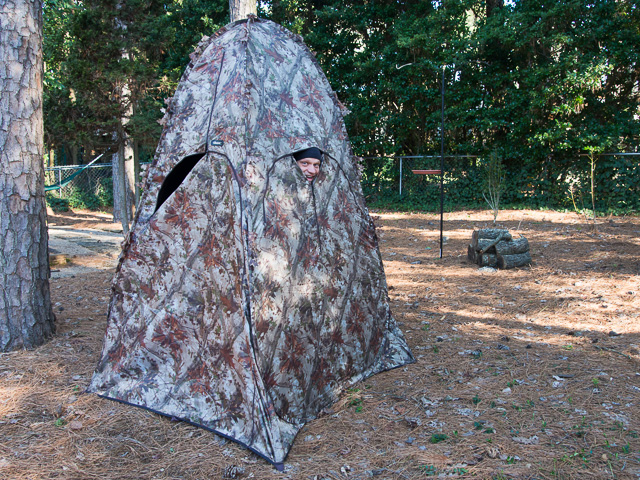
Background
I’m still working on a location that has a good background. Something uniform and natural is best. It should be as far away as possible so it will be heavily blurred. The quality of that blur is called bokeh.
Bokeh is also affected by your choice of lens. A telephoto with a long focal length and wide aperture is best for birds. I like the bird in the shot below, but the background is a little distracting. The problem is that I was using my macro lens for a different project when this bird appeared. For flowers two inches away it has great bokeh, but not at this distance. My Panasonic 45-200mm f/4.0-5.6 does a better job and I used it for the other shots in this article. If you know of a better Micro Four Thirds lens for bird shots then please let me know. I’m ready to shop!
Our Bokeh software let’s you manipulate the background in post processing, but that use of it requires a very careful selection in Photoshop. It’s best to get the background right in the camera and just use our Bokeh tool for creative effects, similar to a Lens Baby. I’ll get into post processing in another article.
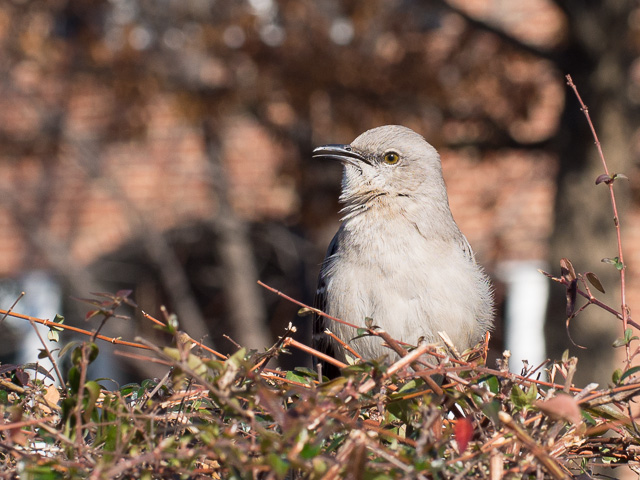
Feeders
I use simple tray feeders with no covering because they attract a wide variety of birds. I started with them hanging from poles adjusted to put the birds at about eye level. I also have a bird bath hanging from one of the poles. The more resources you provide, the more the birds will hang out near you.
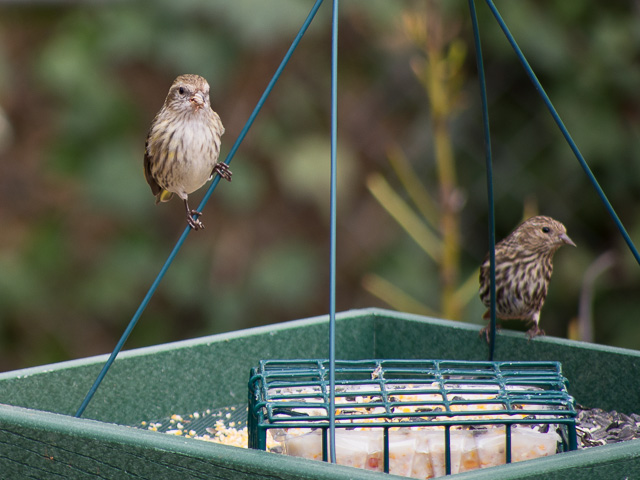
That works, but I got tired of the wires in the scene. I moved one of my tray feeders to a pile of logs and I think it’s an improvement.
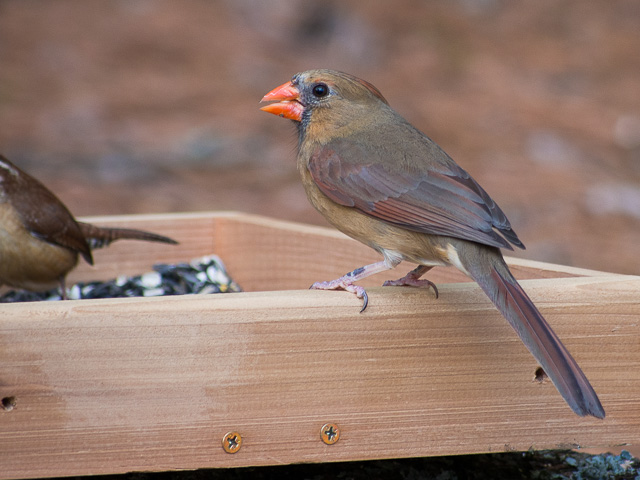
Now I’m working on a more natural scene by getting rid of the artificial feeder altogether. I sprinkle seed directly on a pile of logs. I still need to tinker with this to get birds to stand in a photogenic spot.
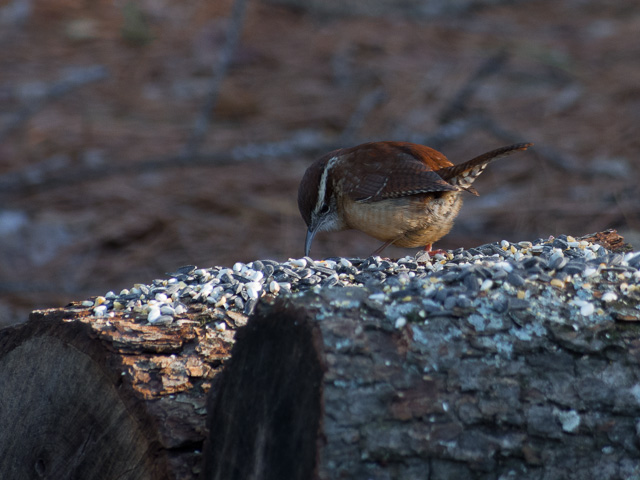
Squirrels
Tray feeders end up feeding a lot of squirrels too. That drives some people crazy, but I think squirrels are almost as cute as birds. If a squirrel shows up while I’m waiting for birds, it’s easy to throw a pinecone to scare it off. I don’t care whether squirrels eat some seed while I’m gone. I add new seed as I start each session.
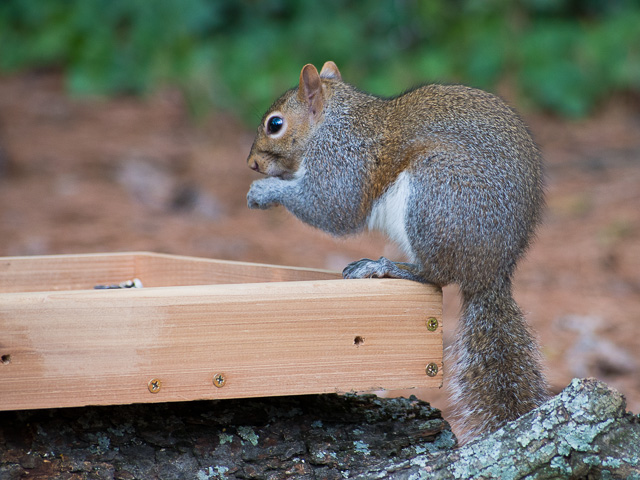
I’ll post an update after I refine my setup. I’m excited to see new birds as they migrate through.
If you like birds then I recommend the recent HBO documentary Birders: The Central Park Effect. It’s available on HBO GO and I think the next airing is March 21, 2013.
Try Exposure Today














That tent is a nice idea! Another option if you have trees close to your windows is to have one way film installed on the glass.
Excellent idea! I’ll try it.
wow ! awesome
Nice approach. To get a more natural setting I recommend using trunks or thick branches from local trees, preferably ones that have already been on the ground for some time and look natural horizontally. Then drill or carve a rather large hole, like 3-5cm in diameter and 2-3 cm deep if possible, to one side of the curving of the log you want to face up. Then make sure the hole is on the opposite side of the top curve of the log from where you’re sitting and fill it with seeds or similar feed. This way the seeds aren’t visible to the camera, the trunk/log looks natural and there’s no sign of manmade intervention.
Excellent advice! My drill is charging now…
Platform feeders trimmed with branches and twigs work well, plenty of perching spots … also a branch or two connecting the platforms. I like a 300 zoom to blur the background.
Thanks for the advice. I like the idea of a branch between the platforms for the birds to stand on without a feeder in the shot.
Rather than sit in a blind, here are two options:
1. A wildlife/game camera that you set-up near the feedtray. Amazon has a bunch, including an 8mp Bushnell.
2. Use Magic Lantern in a Canon camera. Here is a link: http://wiki.magiclantern.fm/userguide#remote-triggers
Note: I’m not associated with either
Both of those are excellent ideas. I’ve been looking at the Wingscapes Audobon 2.0. I’ll probably get one, but for now I’m enjoying the time outdoors and watching the birds for a good shot.
Back Yard action
Cute! Do you know what kind of bird that is? I love the brilliant red head.
Red bellied woodpecker.
there’s actually a small patch of red under the tail… hence the name.
as to the “log” with holes drilled – peanut butter will bring in woodpeckers. Use a baffle above it to keep squirrels away (a milk jug cut to hang near the top of the suspension works well).
Another thing that will bring birds out is water. In winter, a heated bath will have a waiting line. In summer, try for something natural colored. Different heights work well – some birds like water on the ground, some like it raised. This baby cardinal (note the grey feathers on the body… haven’t all turned red yet) was bathing in the yard last year.
Best of all – seek out the native plants birds like (goldfinches love purple coneflowers, black eyed susans). Same goes for butterflies, later in the summer – put the plants in they will lay eggs on, “voila, instant beauty.”
Beautiful! Thanks for all the advice. I’ll work on all of it.
for bird variety, put out a variety of seeds. Cardinals eat corn. Sunflower seed will bring other birds, hulled sunflower in hung feeders and spread on the ground will attract different species.
The bird in your top photo with the bar over the eye is a Carolina Wren (one of the loudest tiny birds in existence). 4th picture down (green feeder tray) shows two female European House Finches (imported to the US as pets)… the males are dull this time of year, close to a brilliant red in the summer. Below that is an immature (1st year) female Cardinal. All cardinals, including males, “fade” in the winter in order to stay better hidden from predators. You can tell this is immature because [a] the crest is flattened rather than standing up and [b] the beak is more brightly colored in adults.
To learn more about bringing nature to your yard, investigate National Wildlife Federation’s Gardening For Wildlife program.
If you’re in the Midwest or East Coast, there are specific material for bringing birds & butterflies at Backyard Habitat. See videos taken in a 50′ x 100′ urban yard.
—————————————————-
Note to Jeff – if this is too much information, feel free to edit… or perhaps start a “guest post…” I am a “Certified Habitat Ambassador Host/Trainer” for the Backyard Habitat program, and was national NWF Volunteer Of The Year in 2007. Bringing nature to the yard is, well, what I love to do! Photo ops without having to go anywhere…
If you deem this not a match for the blog thread, I certainly understand. Just figured I’d share
I LOVE using Snap Art 3 to turn nature (and other) photos into art works. Email me if you want a few examples.
Using an f/2.8 lens will eliminate the need for running images thru additional software to achieve bokeh. I do all I can to not have to spend more time in front of my computer because starring at my computer for extended periods, hurts my eyes. I have been using tents for years, and my specialty is hummingbirds. The distance that I shoot my images really depends on which lens I am using. When I am shooting with my 70-200mm IS II, I am usually less than 4 ft. away, and the hummingbirds react to the sound of my camera, but there is a bit of a trick to getting them used to the sound of my camera because my 5d mark II is quite noisy. I can tell by the images you’ve posted, that you are using an f/4.5 lens, which you will never achieve bokeh with. The new IS II lenses from Canon are AWESOME. Try using one of these new lenses and manually set your ISO at f/5.6, and I guaranty that you will not only achieve beautiful bokeh, but you will also achieve beautiful professional results, and everyone will want to own your images.
Richard, thanks for the advice!
Wow I love those shots. I right away clicked on the link and bought the hunters blind :-) now after payment I shall have that Bokeh. I did a lot of Flower shots and now hopefully catching all the Birds roaming about in the Garden :-) Thank you! Renate.
Feeding the birds is a past time for some people. While you take a stroll with the kids or alone at the park, you may find it interesting to feed the birds. For some people feeding birds is a passion. Bird watchers are not only best at recognizing and naming birds, but also at the knowledge of bird food. Peanuts are most commonly used as bird food as it comes handy in the home kitchens.`
With the onset of autumn wild birds will have started migrating from one place to the other. And in many cases feeding these birds becomes a treat to the eye. But in order to attract a variety of birds it is essential to have the right kind of wild bird food. Along with this you also need to gather knowledge about different varieties of bird feeders, nest boxes and bird baths that attract birds…
Wild bird food preferences vary with bird species. While birds like pigeons and doves will readily eat any bird food given to them, more specialist feeders like Robins prefer small grubs such as mealworms. You can buy bird food from various outlets that have large stocks of bird food available in various weights depending on your requirement. Guides to feeding garden birds can be researched online or from various gardening bird books that give details about wild bird feeding habits. The autumn season can attract a large number of wild birds to your garden with the right food including siskins, goldfinches, great tits, blue tits, wrens, woodpeckers and many more. Each one of them has a different feeding habit and accordingly people can make use of different bird feeders and feeding locations within their garden to encourage them. ”